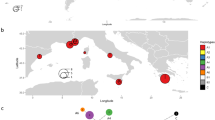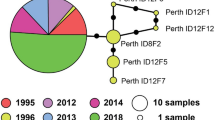Abstract
Tecia solanivora (Lepidoptera: Gelechiidae) is an invasive species that attacks the tubers of the potato Solanum tuberosum. It is considered a serious pest of potato crops and stocks in all countries where it occurs. In the present study, we sequenced 541 individuals sampled across the T. solanivora distribution range, using the mitochondrial DNA marker Cytochrome b (Cytb) to delimit the area of species origin. We also analyzed the genetic structure of T. solanivora in its putative area of origin and described differences in haplotype diversity between samples from different geographic origins affected by the invasion. We observed a gap in the level of genetic diversity between Guatemalan samples (h between 0.77 and 0.97) and those from Costa-Rica, Venezuela, Colombia, Ecuador and the Canary Islands (h between 0 and 0.56). The number of haplotypes has decreased over the colonization process, ending with the observation of a single haplotype in Colombia, Ecuador and the Canary Islands. Consequently, the invasion of South American countries by T. solanivora is likely to have had a front-like step-wise progression, where the most recently invaded country becomes the source of subsequent invasion.

Similar content being viewed by others
References
Ahern RG, Hawthorne DJ, Raupp MJ (2009) Founder effects and phenotypic variation in Adelges cooleyi, an insect pest introduced to the eastern United States. Biol Invasions 11:959–971
Bonavia D (1993) La papa: apuntes sobre sus origenes y su domesticacion. J Soc Am 79:173–187
Bosa CF, Prado AMC, Fukumoto T, Bengtsson M, Witzgall P (2005) Pheromone-mediated communication disruption in Guatemalan potato moth, Tecia solanivora. Entomol Exp Appl 114:137–142
Christiansen JA (1980) Memorias del primer curso nacional de la papa. Sector publico agrícola: ICTA programa regional cooperativo de la papa. Guatemala
Cifuentes JE (1980) Certificación de semilla de papa en Guatemala. Memorias del primer curso nacional de la papa. Sector publico agrícola, ICTA, programa regional cooperativo de la papa. Guatemala 43–46
CIP (2010) Wild potato species catalogue. https://research.cip.cgiar.org/genebankdb/modules/wpsa_old/
Clegg SM, Dignan SM, Kikkawa J, Moritz C, Estoup A, Owens IPF (2002) Genetic consequences of sequential founder events by an island-colonizing bird. PNAS 99:8127–8132
Clement M, Posada D, Crandall K (2000) TCS: a computer program to estimate gene genealogies. Mol Ecol 9:1657–1660
Cognato AI, Sun JH, Anducho-Reyes MA, Owen RD (2005) Genetic variation and origin of red turpentine beetle (Dendroctonus valens LeConte) introduced to the People’s Republic of China. Agric For Entomol 7:87–94
Dangles O, Carpio C, Barragan AR, Zeddam JL, Silvain JF (2008) Temperature as a key driver of ecological sorting among invasive pest in the tropical Andes. Ecol Appl 18:1795–1809
De Walt SJ, Hamrick JL (2004) Genetic variation of introduced Hawaiian and native Costa Rican populations of an invasive tropical shrub, Clidemia hirta (Melastomataceae). Am J Bot 91:1155–1162
Dlugosch KM, Parker M (2008) Founding events in species invasions: genetic variation, adaptive evolution, and the role of multiple introductions. Mol Ecol 17:431–449
Dupanloup I, Schneider S, Excoffier L (2002) A simulated annealing approach to define the genetic structure of populations. Mol Ecol 11:2571–2581
EPPO (2006) Tecia solanivora. European and Mediterranean plant protection organization, data sheets on quarantine pests http://www.eppo.org/QUARANTINE/insects/Tecia_solanivora/DSTECASO.pdf
Excoffier L, Smouse PE, Quattro JM (1992) Analysis of molecular variance inferred from metric distances among DNA haplotypes: applications to human mitochondrial DNA restriction data. Genetics 131:479–491
Excoffier L, Laval G, Schneider S (2005) Arlequin ver. 3.0: an integrated software package for population genetics data analysis. Evol Bioinform 1:47–50
Frankham R (2005) Invasion biology—resolving the genetic paradox in invasive species. Heredity 94:385
Fu YX (1997) Statistical tests of neutrality against populations growth?, hitchhiking and background selection. Genetics 133:693–709
Gallegos P, Suquillo G, Chamorro F et al (1997) La palomilla de la papa Tecia solanivora en el Carchi, situación actual y perspectives de control. Revista INIAP 9:5–6
Giron LF (1984) Celebran seminario sobre la polilla de la papa. Noticia del Instituto de Ciencia y Tecnología Agrícola, Guatemala
Golani D, Azzurro E, Corsini-Foka M, Falautano M, Andaloro F, Bernardi G (2007) Genetic bottlenecks and successful biological invasions: the case of a recent Lessepsian migrant. Biol Lett 3:541–545
Gomez de Paz R (2008) Recopilacion de investigaciones sobre la polilla de la papa Tecia Solanivora, Lepidoptera: Gelechiidae, en Quetzaltenango, Guatemala. Dissertation, Universidad de San Carlos de Guatemala
Grapputo A, Boman S, Lindstrom L, Lyytinen A, Mappes J (2005) The voyage of an invasive species across continent: genetic diversity of North American and European Colorado Potato beetle populations. Mol Ecol 14:4207–4219
Hawley D, Briggs J, Dhondt A, Lovette I (2008) Reconciling molecular signatures across markers: mitochondrial DNA confirms funder effect in invasive North American house finches (Carpodacus mexicanus). Conserv Genet 9:637–643
Hijmans R, Spooner DM (2001) Geographic distribution of wild potato species. Am J Bot 88:2101–2112
Huaman Z, Spooner DM (2002) Reclassification of landrace populations of cultivated potatoes (Solanum sect. Petota). Am J Bot 89:947–965
ICTA (1977) El cultivo de la papa en Guatemala. Folleto técnico Instituto de Ciencia y Tecnologia Agricola no. 6. Instituto de Ciencia y Tecnología Agrícolas, Sector Publico Agropecuario y de Alimentación, Guatemala
Kawamura K, Yonekura R, Katano O, Tanigouchi Y, Sayito K (2006) Origin an dispersal of bluegill sunfish, Lepomis macrochirus, in Japan and Corea. Mol Ecol 15:613–621
Kolbe JJ, Glor RE, Schettino LRG, Lara AC, Larson A, Losos JB (2004) Genetic variation increases during biological invasion by a Cuban Lizard. Nature 431:177–181
Le Roux JJ, Wieczorek AM, Meyer JY (2008) Genetic diversity and structure of the invasive tree Miconia Calvescens in pacific Islands. Divers Distrib 14:935–948
Leal H, Raman K (1989) Scrobipalpoipsis solanivora (Lepidoptera: Gelechiidae) en Centroamérica. Dissertation, Guatemala
Maddison DR, Maddison WP (2000) MacClade: analysis of phylogeny and character evolution 4.06. Sinauer Associates, Sunderland, MA
Meglécz E, Anderson SJ, Bourguet D et al (2007) Microsatellite flanking region similarities among different loci within insect species. Insect Mol Biol 6:175–185
Mooney HA, Cleland EE (2001) The evolutionary impact of invasive species. PNAS 98:5446–5451
Murillo R (1980) Memoria del primer seminario internacional sobre polillas de la papa Scrobipalposis solavivora Povolny y Phthorimaea operculella Zeller. Ministerio de Agricultura y Ganaderia. Costa Rica pp 10–11
Murillo R (1982) Memoria segundo seminario regional sobre investigación y combate de las polillas de la papa Scrobipalposis solavivora Povolny y Phthorimaea operculella Zeller. Ministerio de Agricultura y Ganaderia (PRECODEPA). Costa Rica pp 10–11
Niño L. (2004) Revision sobre la Polilla de la papa Tecia solanivora en Centro y Sur America. Suplemento Revista latinoamericana de la papa:4–21
Notz A (1996) Infliencia de la temperatura sobre la biologia de Tecia solanivora (Povolny) (Lepidoptera: Gelechiidae) criadas en tuberculos de papa Solanum tuberosum. Bol Entomol Venez NS 11:49–54
Povolny D (1973) Scrobipalpopsis solanivora sp. n.—A new pest of potato (Solanum tuberosum) from Central America. Acta Universitatis Agriculturae. Facultas Agronomica 21:143–146
Puillandre N, Dupas S, Dangles O, Zeddam JL, Capdevielle-Dulac C, Barbin K, Torres-Leguizamon M, Silvain JF (2008) Genetic bottleneck in invasive species: the potato tuber moth adds to the list. Biol Invasions 10:319–333
R development core team (2010) R: a language and environment for statistical computing R Foundation for Statistical Computing, Vienna, Austria
Raker CM, Spooner DM (2002) Chilean Tetraploid Cultivated Potato, Solanum Tuberosum, is Distinct from the Andean populations: microsatellite data. Crop Sci 42:1451–1458
Ramos-Onsins SE, Rozas J (2002) Statistical properties of new neutrality test against population growth. Mol Biol Evol 19:2092–2100
Rincón F, López-Avila A (2004) Dimorfismo sexual en pupas de Tecia solanivora. Revista CORPOICA 5:41–42
Rollins LA, Woolnough AP, Wilton AN, Sinclair R, Sherwing WB (2009) Invasive species can’t cover their tracks: using microsatellites to assist management of starling (Sturnus vulgaris) populations in Western Australia. Mol Ecol 18:1560–1573
Rozas J, Sanchez-DelBarrio JC, Messeguer X, Rozas R (2003) DnaSP, DNA polymorphism analyses by the coalescent and other methods. Bioinformatics 19:2496–2497
Rozen S, Skaletsky HJ (2000) Primer3 on the WWW for general users and for biologist programmers. In: Krawetz S, Misener S (eds) Bioinformatics methods and protocols: methods in molecular biology. Humana Press, Totowa, NJ, pp 365–386. Avaible from http://frodo.wi.mit.edu/primer3/
Ruano S, Leal H, Del cid A, Rios E (1984) Generalidades sobre el cultivo de la papa y los efectos causados por polilla en tres areas de Quetzaltenango. Programa Regional Cooperativo de papa PRECODEPA Instituto de ciencia y Tecnología Agrícola. Guatemala
Sakai AK, Allendorf FW, Holt JS et al (2001) The population biology of invasive species. Ann Rev Ecol Syst 32:305–332
Salazar J, Escalante W (1984) La polilla guatemalteca de la papa, Scrobipalpopsis solanivora, nueva plaga del cultivo de la papa en Venezuela. Jornadas Agronómicas 9:24–28
Sax DF, Stachowicz JJ, Brown JH, Bruno JF, Dawson MN, Gaines SD, Grosberg RK, Hastings A, Holt RD, Mayfield MM, O’Connor MI, Rice WR (2007) Ecological and evolutionary insights from species invasions. Trends Ecol Evol 22:465–471
Simon-Bouhet B, Garcia-Meunier P, Viard F (2006) Multiple introductions promote range expansion of the mollusc Cyclope neritea (Nassariidae) in France: evidence from mitochondrial sequence data. Mol Ecol 15:1699–1711
Spooner DM, McLean K, Ramsay G, Waugh R, Bryan GJ (2005) A single domestication for potato based on multilocus amplied fragment length polymorphism genotyping. PNAS 102(41):14694–14699
Tajima F (1989) Statistical methode for testing the neutral mutation hypothesis by DNA polymorphism. Genetics 123:585–595
Templeton AR, Crandall KA, Sing CF (1992) A cladistic analysis of phenotypic associations with haplotypes inferred from restriction endonuclease mapping and DNA sequence data. III. Cladogram estimation. Genetic 132:619–633
Torres F (2003) Polilla de la papa Tecia solanivora (Povolny). Plagas agrícolas de Venezuela, Ficha técnicas de organismos plaga, Cultivo: Papa. Solanum tuberosum. Sociedad Venezolana de Entomología. http://www.plagas-agricolas.info.ve/fichas/cultivo_x_plaga.php?plaga=175
Wang Ch, Li S, Fu C, Gong X, Huang L, Song X, Zhao Y (2009) Molecular genetic structure and evolution in native and colonized populations of the Chinese mitten crab, Eriocheir sinensis. Biol Invasions 11:389–399
Wares JP, Hughes AR, Grosberg RK (2005) Mechanisms that drive evolutionary change: insights from species introductionsand invasions. In: Sax DF, Stachowicz JJ, Gaines SD (eds) Species invasions: insights into ecology, evolution and biogeography. Sinauer, Sunderland, pp 229–257
Zhang BC (1994) Index of economically important Lepidoptera. CAB International, UK
Zhou WG, Rousset F, O’Neill S (1998) Phylogeny and PCR-based classification of Wolbachia strains using wsp gene sequences. Royal Soc London 265:509–515
Acknowledgments
The authors wish to thank the Instituto de Ciencia y Tecnología Agrícolas ICTA in Guatemala, especially the engineers Gustavo Tobar, Guillermo Chavez and Pedro Lacán and the agriculturalist Isabel López García; the Instituto Nacional de Investigación y Transferencia de Tecnología Agropecuaria INTA in Costa Rica; the Instituto Nacional de Investigaciones Agrícolas INIA in Venezuela, especially Alonso Antonio Arroyo; and the Corporación Colombiana de Investigación agropecuaria CORPOICA in Colombia and the Instituto Canario de Investigaciones Agrarias ICIA in the Canary Islands, for their help in collecting samples and for sharing information. The authors also express their thanks to Florence Mougel, Daniel Couch and two anonymous referees for their helpful comments and suggestions for improving the manuscript.
Author information
Authors and Affiliations
Corresponding author
Rights and permissions
About this article
Cite this article
Torres-Leguizamón, M., Dupas, S., Dardon, D. et al. Inferring native range and invasion scenarios with mitochondrial DNA: the case of T. solanivora successive north–south step-wise introductions across Central and South America. Biol Invasions 13, 1505–1519 (2011). https://doi.org/10.1007/s10530-010-9909-2
Received:
Accepted:
Published:
Issue Date:
DOI: https://doi.org/10.1007/s10530-010-9909-2




